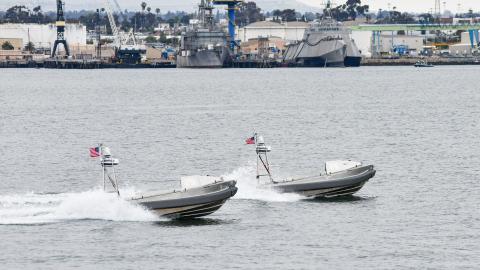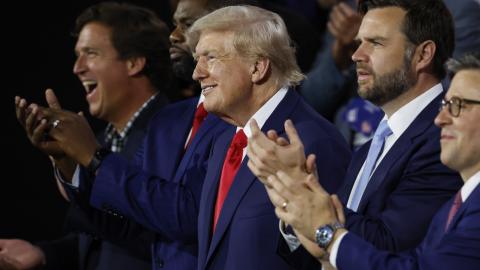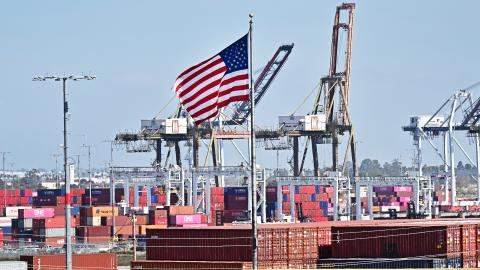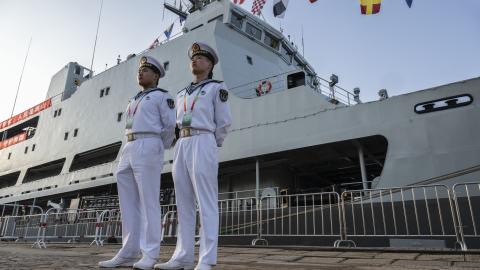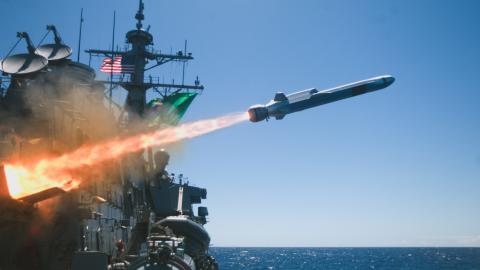Executive Summary
Senior American policymakers and military leaders want and need to know how the United States stands in key military competitions relative to its rivals. This net assessment examines the balance of strategic forces (the strategic balance) between the United States and its two principal rivals, the People’s Republic of China (PRC, or “China”) and the Russian Federation (“Russia”). The assessment examines the current balance as well as trends that may alter the balance significantly over the planning horizon, defined as the 2025–40 time frame.
During the Cold War, the term strategic forces referred to nuclear weapons deployed on strategic delivery systems: intercontinental ballistic missiles (ICBMs), submarine-launched ballistic missiles (SLBMs), and long-range bombers (LRBs). This taxonomy was codified in the Strategic Arms Limitations Talks (SALT) and in the SALT I and II agreements negotiated between the United States and Soviet Union. Strategic defenses were those forces capable of defending effectively against attacks by these forces. This assessment retains this taxonomy with two important additions.
First, following the Cold War, new capabilities emerged that could, under certain circumstances, perform some strategic strike operations1 that were once the exclusive domain of strategic nuclear forces. This is the case with respect to long-range delivery systems armed with precision-guided munitions, or non-nuclear strategic strike (NNSS) forces. Second, cyber weapons were introduced. Many believe they have the potential to threaten a state’s critical infrastructure (CI), its strategic force command, control communications, and computer (C4) systems, and its intelligence, surveillance, and reconnaissance (ISR) systems.
Combined with strategic nuclear systems, NNSS and cyber forces constitute an expanded strategic triad, supplementing the nuclear triad of land-based, sea-based, and airborne delivery systems. That said, given their proven ability to inflict prompt catastrophic destruction against the full range of strategic counterforce and countervalue targets, nuclear weapons remain far and away the most important strategic force. Consequently, they are this assessment’s principal focus.
US Objectives
The US strategic forces’ primary purpose is to influence the behavior of America’s rivals, allies, and security partners. By far their most important objective is to deter2 a general nuclear exchange that would destroy the United States’ ability to function as a coherent political, economic, and social entity. Yet US strategic forces have objectives beyond avoiding Armageddon. These secondary objectives can be summarized as:
- Improving the United States’ ability to achieve favorable outcomes when confronting political-military crises;
- Deterring major acts of non-nuclear aggression that would compromise vital US strategic interests (such as a Chinese attack on Taiwan, or a Russian attack on a North Atlantic Treaty Organization [NATO] ally);
- Deterring any form of nuclear attack, however limited, upon the United States, to include its military forces deployed overseas, as well as attacks against those allies and security partners accorded shelter under the US nuclear umbrella through extended deterrence; and
- Limiting the spread of nuclear weapons.
Should deterrence fail, America’s strategic forces can enhance the US military’s operational effectiveness by:
- Deterring aggressors in a general conventional war from escalating to strategic weapons use—especially nuclear weapons use—as well as deterring a limited nuclear war from crossing the threshold to a general nuclear war;
- Minimizing the damage to the United States in the event of a limited attack by a minor nuclear power, or in case of accidental launch of a limited number of strategic weapons against US targets, by conducting targeted strategic strikes against an adversary to limit its ability to inflict further damage on the American homeland;
- Providing the national command authority with the ability to order limited and flexible strategic-strike operations; and
- Sustaining a favorable strategic force balance in the event of a general conventional war in which strategic forces suffer attrition.
Chinese and Russian Objectives
China and Russia seek to avoid a general strategic exchange with the United States. They also see their strategic forces enabling them to expand their freedom of action in support of efforts designed to increase their influence both regionally and globally while diminishing US influence. Toward this end, Beijing and Moscow have established a “no limits” partnership.3
Problems Estimating the Balance
Assessing the strategic forces balance is a challenging proposition, much more so than comparable efforts during the Cold War. China’s apparent decision to expand its nuclear arsenal to match those of Russia and the United States seems destined to affect a shift from the bipolar strategic forces system to a tripolar system within the next decade. Should this occur, for the first time Washington will have to account for two roughly equivalent rival nuclear powers.
Such an assessment also suffers from a lack of data to inform and support analysis, especially in an unclassified assessment like this one. Nor can analytic tools like war games or computer simulations provide, with high confidence, predictions of actual outcomes of what would be the world’s first war between great powers with nuclear forces.
Efforts to assess how the strategic forces balance might shift in the coming years—when current senior US defense policymakers have the greatest opportunity to influence the American military’s capabilities—are hampered owing to uncertainty over other governments’ actions, which can be highly unpredictable. The same is true for emerging technologies: there is uncertainty over when they may mature and how rapidly they can be applied to enhance strategic forces’ effectiveness.
Consequently, assessments of the strategic forces balance depend, to a substantial degree, on professional judgment.
The Current Balance
Today there are two great nuclear powers, the United States and Russia, and seven lesser nuclear powers: the United Kingdom, France, China, India, Pakistan, the Democratic People’s Republic of Korea (DPRK, or North Korea) and Israel (an undeclared nuclear power). The US and Russian nuclear arsenals comprise over 87 percent of the world’s nuclear weapons and nearly 90 percent of the deployed weapons. Under the terms of the New Strategic Arms Reduction Treaty (START), the United States and Russia maintain a rough parity in strategic nuclear forces. That said, there are significant asymmetries between American and Russian nuclear forces, with the former emphasizing the sea and (to a lesser extent) air legs of its triad, and the latter its land-based missile force. China, whose overall arsenal is estimated at around a tenth of each of the American and Russian arsenals, is engaged in a large-scale expansion, apparently with the intent of becoming the world’s third great nuclear power. As with Russia, China’s nuclear triad of forces is weighted toward land-based missiles.
With regard to NNSS forces, the United States has a clear lead in its ability to conduct non-nuclear precision kinetic attacks on a global scale, to include against strategic counterforce targets in China and Russia. The US advantage stems primarily from its fleet of long-range bombers and air refueling tankers; a global basing architecture; nuclear-capable strike aircraft located at forward air bases; and decades of experience in NNSS operations. This force is supplemented by maritime forces equipped with Tomahawk land-attack cruise missiles (TLAMs), particularly those on the US Navy’s four guided-missile submarines. Although the NNSS balance favors the United States, its advantage is modest. The US military currently possesses only a handful of stealth bombers, and its defense industrial base cannot surge the production of precision-guided munitions and extended-range missiles.
The strategic cyber forces component of the balance is by far the most difficult to assess, primarily because open-source information regarding the three competitors’ cyber capabilities is lacking. Furthermore, there has been no strategic cyber great power war, and thus no data on the prospective effectiveness of cyber strategic-strike operations. Hence, any assessment of the cyber balance is bound to rest especially heavily on judgment. Unclassified assessments of national cyber forces capabilities with respect to intelligence, offensive, and defense capabilities suggest that, overall, the United States enjoys a significant advantage in this area of the strategic forces balance.
However, the Chinese, and perhaps the Russians, appear to view the overall current strategic balance as less favorable to them than as expressed in this assessment. Both Beijing and Moscow believe the United States enjoys a significant advantage in its ability to wage strategic warfare effectively below the nuclear threshold through a combination of conventional precision and cyber strikes, supported by missile and cyber defenses. They are also apprehensive over their ballistic missile submarines’ (SSBNs’) vulnerability to US anti-submarine warfare (ASW) forces. Hence, both adversaries are modernizing their strategic forces, and China is expanding its nuclear forces.
With respect to accomplishing US objectives, the net assessment finds:
- The current strategic forces balance appears sufficient to deter a bolt-from-the-blue general nuclear attack on the United States or its allies. Were such an attack to occur, it would far more likely emerge out of a major crisis or from a great power general war that escalates to a general strategic nuclear exchange.
- Regarding potential major crises between the United States and China and/or Russia, such as what happened during the Cuban Missile Crisis in 1962, or what might occur if China were to invade Taiwan:
- US strategic forces would likely not exert a significant coercive effect over Russia.
- In the near term, US strategic forces would provide a substantial coercive effect against China. Chinese writings reveal their perception of a US advantage, and Beijing’s strategic forces expansion appears to be intended, at least in part, to eliminate it.
- As Beijing’s strategic forces approach a rough balance with those of the United States, its acts of coercion and conventional aggression—particularly along the First Island Chain—will become far less risky propositions, and the Western Pacific conventional force balance will assume greater importance.
- Depending upon how long a crisis persists, the ability to sustain a generated strategic force alert posture appears to be more of a problem for the United States, given its emphasis on SSBNs relative to China and Russia, who place greater emphasis on land-based ballistic missiles. These boats require periods of extended maintenance, limiting their ability to surge and extend deployments.
- Over the past decade both Russia and China have demonstrated significantly more freedom of action4 than was the case during the United States’ so-called unipolar moment following the Cold War. These actions, however, were undertaken independent of any major shift in the strategic forces balance, which suggests other factors are at work.
- As for extended deterrence, the progressive—albeit modest (thus far)—loss of US overall nuclear parity vis-à-vis the combined Sino-Russian arsenals has not triggered serious concerns among America’s allies and partners with respect to Washington’s nuclear guarantee. Nor have any US allies or security partners made a significant attempt to acquire their own nuclear arsenal.
This may change as China continues to build up its strategic and theater nuclear forces, as well as its NNSS and cyber capabilities. Absent offsetting US efforts, China’s actions will very likely reduce US allies’ confidence regarding extended deterrence. Such concerns will likely be especially acute among America’s Western Pacific allies.
The US strategic forces modernization program, which was laid down before China’s buildup became known, has not been adjusted to reflect this major shift in the competitive environment. Absent countervailing action by Washington, its position is likely to degrade over time, increasing the potential for Chinese or Russian coercion of US allies or security partners. This could find states such as Japan, South Korea, or Taiwan developing their own nuclear forces. - While the United States has a limited ability to defend itself from a nuclear attack by a minor power, its multidimensional (nuclear-NNSS-cyber) expanded triad of strategic forces provides a formidable deterrent against such attacks.
- In a conventional great power war, the United States’ current advantages in global NNSS, undersea warfare, and (possibly) cyber strategic strike forces may provide an opportunity to significantly shift the strategic forces balance in its favor through selective non-nuclear and cyber counterforce attacks against Chinese and Russian strategic forces and supporting infrastructure.
Key Trends and Asymmetries
American senior policymakers can do little to affect the strategic forces balance in the near term, as boosting the production of existing capabilities typically takes years, and introducing new capabilities takes even longer. Since their influence on the military balance is likely to be greatest a decade or so in the future, these policymakers are keen to know how the strategic forces competition will change over time.
Current trends indicate that over the next decade or so the strategic balance will likely shift significantly to the United States’ disadvantage, and to Russia’s as well. China, on the other hand, stands to experience a major favorable shift in the balance. The following key trends show why.
Tripolar Nuclear System
If China’s strategic forces buildup continues along its current trajectory, by the mid-2030s it will create a Sino-Russo-American tripolar system where a rough parity exists among the three rivals. In such a system, the United States will have far more difficulty establishing and sustaining force postures that enable it to meet key strategic force objectives at anything close to current levels. For example, maintaining a rough nuclear parity with both China and Russia will no longer be possible. The US will also struggle to maintain a secure second-strike assured destruction capability against both powers.
As their combined strength comes to exceed that of the United States, Beijing (especially) and Moscow would likely experience a substantial increase in their freedom of action, both locally and globally. For the United States, the loss of parity could also erode its allies’ confidence in extended deterrence, making them more vulnerable to Chinese or Russian coercion. Moreover, faced with this situation, some US allies will have a significantly greater incentive to become nuclear powers themselves.
A World of Low Numbers
If the result of China’s nuclear buildup finds the three rivals with forces at roughly New START levels, the result would be a tripolar system in a World of (Relatively) Low Numbers. In this case, Beijing would have significantly reduced the entry barrier for other states with aspirations of fielding and sustaining a great power nuclear arsenal. India, Japan, and South Korea appear to be the states with the greatest incentive and ability to do so.
A World of High Numbers
A key issue in assessing the future of nuclear forces balance centers on whether the World of Low Numbers will remain or a World of High Numbers—a period of explosive growth that characterized much of the Cold War era—will return.
Current trends argue for the latter outcome. The pace of nuclear weapons growth has accelerated recently as China sprints to expand its arsenal. Nor do trends in arms control offer encouragement. Both the Anti-Ballistic Missile (ABM) Treaty (2002) and Intermediate-Range Nuclear Forces (INF) Treaty (2019) have been terminated. In February 2023, Russia suspended its participation in New START. China has shown little enthusiasm for engaging in arms control discussions. Nor is it clear that Beijing will stop its buildup once its nuclear forces match US and Russian levels.
Russia and China also have to account for nearby nuclear-armed rivals, such as France and Great Britain in the case of the former, and India in the case of the latter, as well as each other’s strategic forces. Under these conditions, Russia and (especially) China may not feel content living in a World of Small Numbers. Were one or both of these powers to expand their arsenals beyond New START levels, owing to America’s eroded nuclear industrial base, the United States could find itself slow to get out of the starting gate.
The emergence of a World of High Numbers would pose significant advantages—and problems—for the United States. For example, it’s possible that either China or Russia may remain at or near New START levels, while the other pursues expansion. If so, the United States could reestablish a bipolar system, albeit one with new characteristics. A bipolar World of High Numbers that, say, finds China and the United States with 10,000 deployed strategic weapons each, while Russia remains roughly at New START levels could, in theory, “solve” the tripolar world’s parity problem and address assured destruction requirements as well. A World of High Numbers would also establish a much higher barrier to entry for those nuclear-armed states aspiring to achieve parity with their most powerful rivals. Should this Sino-American bipolar system emerge, it might allay considerably the concerns of those states sheltering under the US nuclear umbrella.
Breakout
The United States will need to maintain an option to expand its strategic nuclear forces should Russia decide to break out of New START levels in the near term and/or China continues expanding its forces once it has reached parity with its two tripolar rivals. Russia has a near-term advantage over China and the United States. It has warm missile production lines (which the US currently lacks) and plenty of stored warheads and additional fissile material (which China lacks).
China also has a warm missile production line and a surplus of missiles. A key issue here is whether a market in fissile materials will develop in which Russia, North Korea, and (perhaps) Pakistan meet China’s needs. If so, depending upon its ability to fabricate nuclear weapons, Beijing could become a breakout threat much sooner than the mid-2030s, when its nuclear arsenal is projected to reach New START limits. Once the People’s Liberation Army (PLA) has a surplus of fissile material, it will be possible to convert its conventional ballistic missile payloads to carry nuclear warheads. During the Cold War, there were concerns that Soviet Russia could convert its SS-20 intermediate-range ballistic missiles (IRBMs) to ICBMs on relatively short notice. The same might hold true with respect to China’s numerous IRBMs.
The United States’ two principal nuclear rivals enjoy an advantage in missile throw weight, or weapons payload capacity. Finally, there are serious concerns as to whether the US nuclear industrial infrastructure can meet the breakout challenge if and when it presents itself.
The Target Set: Countervalue
The concept of assured destruction has been a key factor in preserving crisis stability. Having an assured destruction capability with respect to Russia, however, is not the same as having one for China. Since the three powers have vastly different populations and geographies, each has different requirements for establishing an assured destruction force against the other two. For example, Russia’s population is around one-tenth that of China’s, and its industrial base is far smaller as well. Thus, all other factors being equal, the United States’ requirements for maintaining an assured destruction capability for China would be significantly more demanding than that which it has maintained against Russia.
The Target Set: Counterforce
At present, the United States appears to enjoy an advantage over China and Russia with respect to counterforce attacks, thanks in large part to having a substantially greater percentage of its nuclear arsenal aboard its SSBNs, which are very difficult to detect and, thus, to attack. China and Russia, on the other hand, place far greater emphasis on their land-based missile forces that—especially in the case of those positioned in fixed silos—are far easier to detect.
This US advantage is partially offset by Chinese and Russian mobile ballistic missiles, which are relatively more difficult to locate and engage than US silo-based ICBMs. It’s also possible that China’s large-scale construction of fixed silos could be employed as part of a shell-game basing posture, complicating efforts at detection. Furthermore, individual ballistic missiles carry only a small fraction of the weapons aboard an American SSBN. This enables land-based missile forces to assume a far more dispersed basing posture than their seaborne counterparts. Current plans further erode the US advantage by calling for its bombers to be located at a few bases, and its SSBNs at two ports, placing, as it were, many nuclear eggs in a few baskets.
Current technology trends find some subject matter experts expressing concerns that, over the next decade or so, the oceans will become far less opaque, leading to a disruptive shift in favor of ASW forces. If so, the dominant leg of the US nuclear triad will find it increasingly difficult to avoid detection, its principal means of defense.
The Strategic/Theater Balance
If the emerging tripolar system produces a rough parity in strategic delivery systems at relatively modest (New START) levels—a World of Low Numbers—then China and Russia will likely have strong incentives to build theater nuclear systems to offset the arsenals of India and the two NATO nuclear powers, respectively—and perhaps each other, as well. China already has a large inventory of theater ballistic missiles, and Russia—now freed from INF Treaty constraints—seems likely to follow suit. If so, the United States would be at a serious numerical disadvantage in theater nuclear systems, with serious implications for the United States’ extended deterrence guarantees to its European and Asian allies.
Arms Control
For over a century, going back to the Washington Naval Treaty, the American people and their leaders have expressed faith in the ability of arms control treaties to enhance their security. Indeed, the United States is the only tripolar power with a strong arms control lobby. Furthermore, US domestic voices calling for greatly expanded government spending on social welfare overwhelm those advocating for increased defense funding. This, combined with rapidly growing debt and associated increased interest payments, and an aversion to increased taxation, makes substantial increases in defense spending an increasingly remote possibility.
In combination, these factors will likely further increase the pressure on US political leaders to reach an accommodation with China and Russia to avoid increased funding for defense in general, and strategic forces in particular. Yet, for these reasons, when it comes to arms negotiations, especially with respect to China, the United States may well find itself playing a weak hand.
Areas for Further Research
Tripolar System Characteristics
As deterrence plays a central role in US strategic forces’ ability to fulfill their purpose, senior policymakers would benefit from an enhanced understanding of Chinese and Russian views of a tripolar system. Analysis on this issue should include how Beijing and Moscow view the advantages and drawbacks with respect to a world of low or high numbers. Additional analysis on middle power (e.g., German, Indian, Japanese, South Korean) views would help inform thinking on US extended deterrence guarantees, and the potential for further nuclear proliferation.
The ICBM Asymmetry
The asymmetry between the calls from a significant element of the US strategic studies community to reduce the US nuclear triad to a dyad by eliminating its land-based deterrent, and the Chinese and Russian emphasis on ICBMs merits inspection. The asymmetry extends even further: a significant portion of Chinese and Russian ICBMs are mobile and MIRVed (multiple independently targetable reentry vehicle), while US ICBMs are not. These asymmetries may represent major differences in these countries’ objectives and nuclear doctrines relative to those of the United States.
Theater Strategic Forces
Theater strategic forces are likely to play an increasing role in the overall balance. Consequently, senior US defense policymakers would benefit from an analysis of Chinese and Russian views on how theater strategic forces will influence the strategic balance. Another assessment should be made to determine how US allies relying on its extended deterrence will react should Chinese and Russian theater strategic forces expand significantly.
Undersea Warfare
Are current technological trends moving away from an undersea warfare competition that, from a US perspective, has long been stable and favorable (in terms of US SSBN stealth)? Are these trends transitioning the competitive environment to one in which ASW forces are gaining the upper hand? Or is the competition likely to become dynamic, much as was the case during the Battle of the Atlantic in World War II, lurching back and forth between advances in submarine detection and those enhancing stealth? A net assessment of the undersea competition should be conducted to address these and related issues.
The Cyber Balance
The three rivals’ cyber capabilities are even more opaque than those relating to the undersea competition. Given cyber strategic forces’ touted potential, especially against CI targets, an assessment on this aspect of the strategic forces balance is merited.
The Target Set
A tripolar system’s counterforce and countervalue target set will shift in scale and form from the current set. In particular, the implications of China’s far greater economic might and population than Russia’s need to be examined with the objective of determining US strategic force requirements to maintain an assured destruction capability.
Arms Control
Arms control negotiations offer the prospect of improving the United States’ competitive position. Given US strategic force objectives, there may be room for agreement on terms that would be to Washington’s advantage. With this in mind, analysis might profitably be undertaken to assess the implications of agreements that ban MIRVed and dual-use missiles; ways of employing ballistic missile defenses that drive up attacker costs (such as through preferential defense); and banning theater nuclear ballistic missiles—a tripolar INF Treaty, if you will. Naturally, any agreement would need to include strong measures to preclude a level of cheating that would compromise US security objectives.
To strengthen its hand in any negotiations, the United States should come to the table possessing a broad range of options for expanding and enhancing its strategic force capabilities. At a minimum, this would require restoring the US nuclear industrial base and maintaining warm delivery system production lines.
Highly Skilled Strategists
This assessment finds the United States confronting a very different competitive environment with respect to the strategic forces balance than that which characterized the Cold War and immediate post–Cold War eras, with even greater changes likely to occur over the next decade or so. Recent and existing trends indicate that, absent corrective action, the strategic balance will continue shifting in Russia’s and (especially) China’s favor.
Given these trends, and the importance of the strategic forces balance to US security, the need to develop strategies to improve America’s position cannot be understated. During the nuclear age’s early days, many of the country’s best strategic minds—such as Bernard Brodie, Herman Kahn, William Kaufmann, Henry Kissinger, Andrew Marshall, Thomas Schelling, and Albert Wohlstetter—focused on these issues. A similar effort by contemporary strategic study community’s best thinkers is needed. Identifying these individuals, and informing and supporting their efforts, will be among the most important initiatives the Defense Department can pursue.
